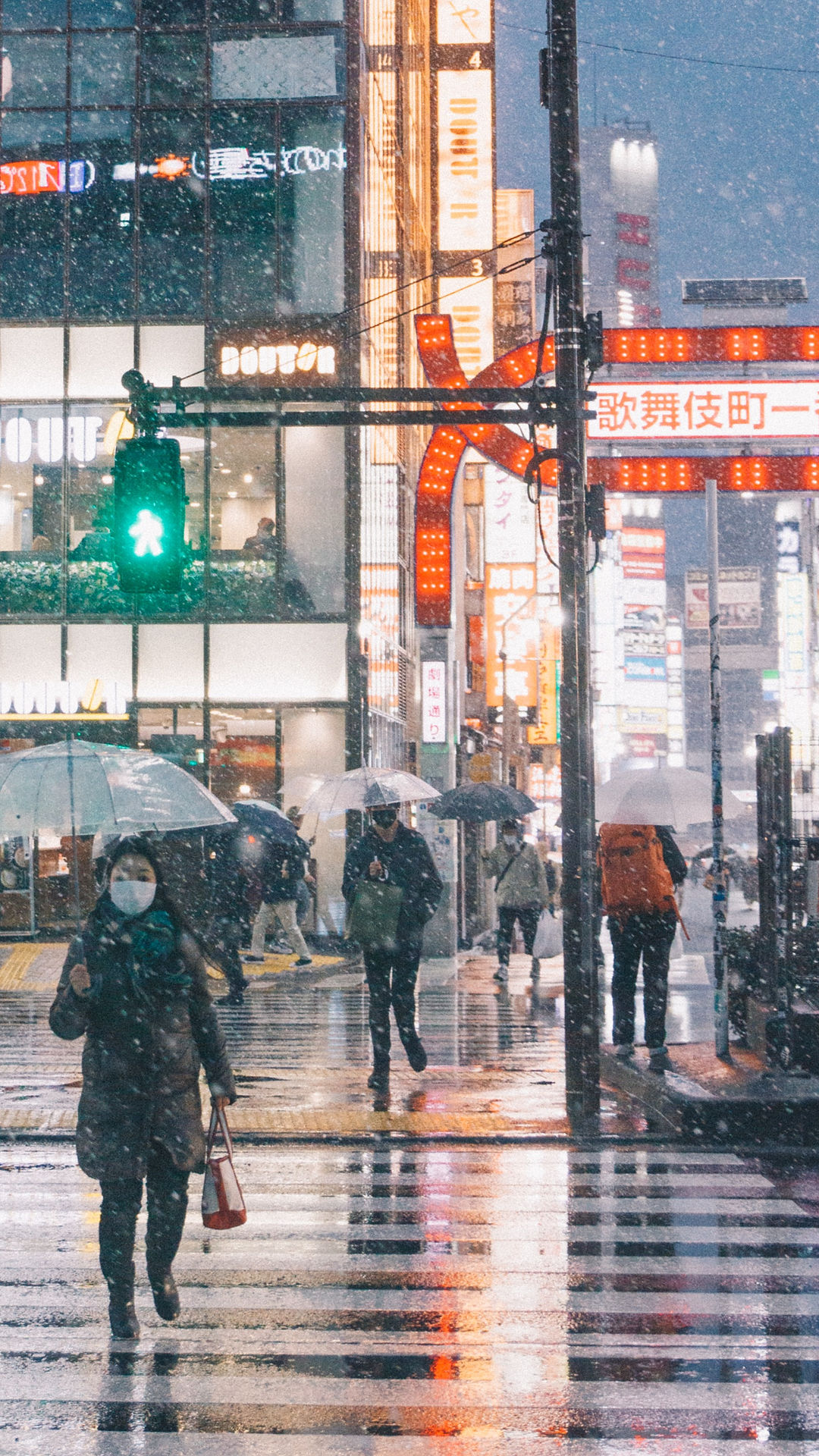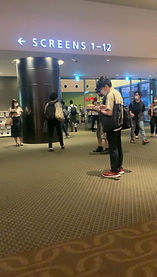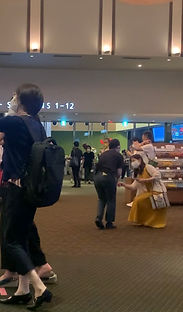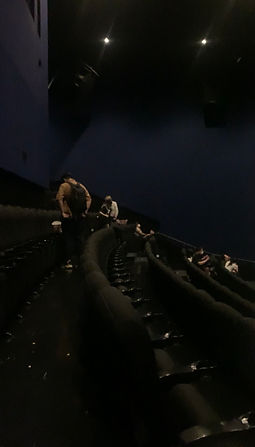
Following Social Order
Toho Cinema
by Reio
As you walk down the main street of Kabuki-cho, you feel the pressure of the nightlife on your shoulders. Like a fish out of water, you have to follow the rules written out by the insider nightlife workers and “residents” of Kabuki-cho. At the end of the street you come across an escalator. That of which like the stairs to heaven, leads the way to a world that you are much more familiar with. When you step foot into the grounds of Toho-Cinema, like being put back into the water, you are able to breath and act as though you are at home.
Introduction
Every society has rules and social order and in many cases, that social order is based on the idea of insiders and outsiders. In the streets of Kabuki-cho the insiders are the nightlife workers, while the outsiders are the visitors from outside of the area. However, there is a place where the roles reverse; where the social order is created by the ones from outside of Kabuki-cho. That is Toho-Cinema. This page attempts to define that social order and show how people follow those social rules.
“If researchers are correct in understanding how everyday urban life is normally conducted, they should, then, be able to predict how persons will behave once these “normal” routines have been disrupted.” (Karp page 102)
the metropolitan type - which naturally takes on a thousand individual modifications - creates a protective organ for itself against the profound disruption with which the fluctuations and discontinuities of the external milieu threaten it. (Simmel page 12)
Social order for the metropolitan type is created through the views that this organ creates. More simply put, a metropolitan person is exposed to a myriad of external factors that, if they were to react to every single thing, they would be unable to keep their own identities stable. People are affected deeply by the things they see and experience. Therefore, a metropolitan person has to learn to shut those disruptions out. From the examples found above, the social order in Toho Cinema, seems to be heavily based on this metropolitan mindset that can be found across Tokyo. People do not want to interact with each other in order to protect themselves. This is very peculiar, considering that Kabuki-cho is a place where those interactions are considered to be very normal. This difference emerges because the ones creating the social order changes from the more interactive night workers of Kabuki-cho to the more Tokyo metropolitan type of people who are visitors to the city.
Waiting Area
The second you walk through the doors, you are greeted by a large open area filled with people waiting for people, snacks, tickets, or maybe for their movie to start. When people are waiting for whatever reasons they have, there is a social order that is created and protected by the people there.
Avoiding contact to any other groups
This is something that is done to avoid conflict or interaction between people. Perhaps this shows the aspect of metropolitan people and how it is similar in Toho Cinema. On the street or outside, it would feel fairly awkward to be waiting in the open space, but at Toho Cinema, people will choose to wait and stand in open areas so that they do not interfere with others. On two separate days, people were found waiting looking at their phones in the open area.



Ignoring people who seem to be having trouble (besides employees)
People who seem to be having trouble or are kind of lost are often ignored by the other customers. This may show the way that people try to protect social order, by not making a big deal of these kinds of scenes. Even when something out of the norm happens, the reactions of a metropolitan person would be to ignore the situation. On the right is a scene where a woman had dropped her tickets, and a few other contents from her hand, and while the people around her had ignored the incident, the person that came to help was an employee.
Silent pressure
Silent pressure is used to get people to move. Instead of asking, the action of choice for most people in Toho Cinema is to peek and look at the items to show that they are interested. Underneath is a picture of when an older male had brought out his phone to gesture that he wanted to take a picture of some of the fliers when there were people blocking. On the right is another example, where this young man was leaning and peeking, from quite a distance I may add, at the goods area in order to express his interest. Confrontation is something that is a no go under the social order in Toho Cinema, and this patient act of pressure is the way that people get around it.



Moving to secluded areas, (bathroom, walls, other small spaces) to talk about private things
Moving to secluded areas is a way for people to find places where they can speak a little louder or about something that may be private. The bathroom hallway looks to be the most popular for this, and the people that often use this area are people who look to be “Dohan” or a customer and a host/ hostess. This specifically shows the fact that the night workers understand that they are the outsiders, and they will try to act according to social order by doing such things. The image on the right is of a middle-aged man, who seemed to be dressed quite well, with a younger female. While quite hard to hear the conversation, they were leaning into each other and making sure that people do not hear, because the second I walked passed, the two dispersed and both of them entering their respective bathrooms.
In the Theater
After meeting up with your friends, you head into the movie theater and find yourself in a room where social order can be seen in a different way to that of the actions seen while waiting.
Leaving spilled popcorn to be cleaned by workers
This is similar to the included term about ignoring people who are having trouble. People try to ignore things that would seem to cause a big scene. This is a way to follow social order that is not only perpetuated by the customers, but by the staff as well. It is deemed to be okay to leave messes that you have made, because someone is going to be there to clean it. From the perspective of the staff, it seems to be that it is also to make sure that the exiting of the theater is done smoothly in order to get ready for the next film showing. While it would probably be more polite clean it up yourself, people will often choose to follow social order over what may seem polite.

“Dohan” waiting for everybody to leave after movie ends
“Dohan” leaving right as the credits start rolling
These two acts of following social order is another example that shows that the outsiders, or night workers, understand that they are not the insiders at Toho Cinema. As the film almost comes to an end, you can see pairs, often where the male is dressed up in brand clothing, and the female is wearing “menhera” or “Jirai-kei” clothing, exiting the theater as soon as the credits begin. If you wait through the credits, then you can observe the other, seemingly “Dohan,” pairs wait until most of the people leave before even getting up from their chairs. It is quite hard to see, but the pair farthest from the camera (male in white shirt) had stood up to stretch, but then sat down again and waited until most of the people had left. It can be seen from the image that even at this point there were already very little people left, but they would still wait. It seems that the outsiders in Toho Cinema understand that they are not the insiders and will act according to social order in order to not interfere with others.
Now that we understand the outsiders and insiders of Toho Cinema, and how each will act to follow the social order, we will look into different ways that people can disrupt that balance. Observing the ways that social order is broken.
Sections
toho cinema
.png)